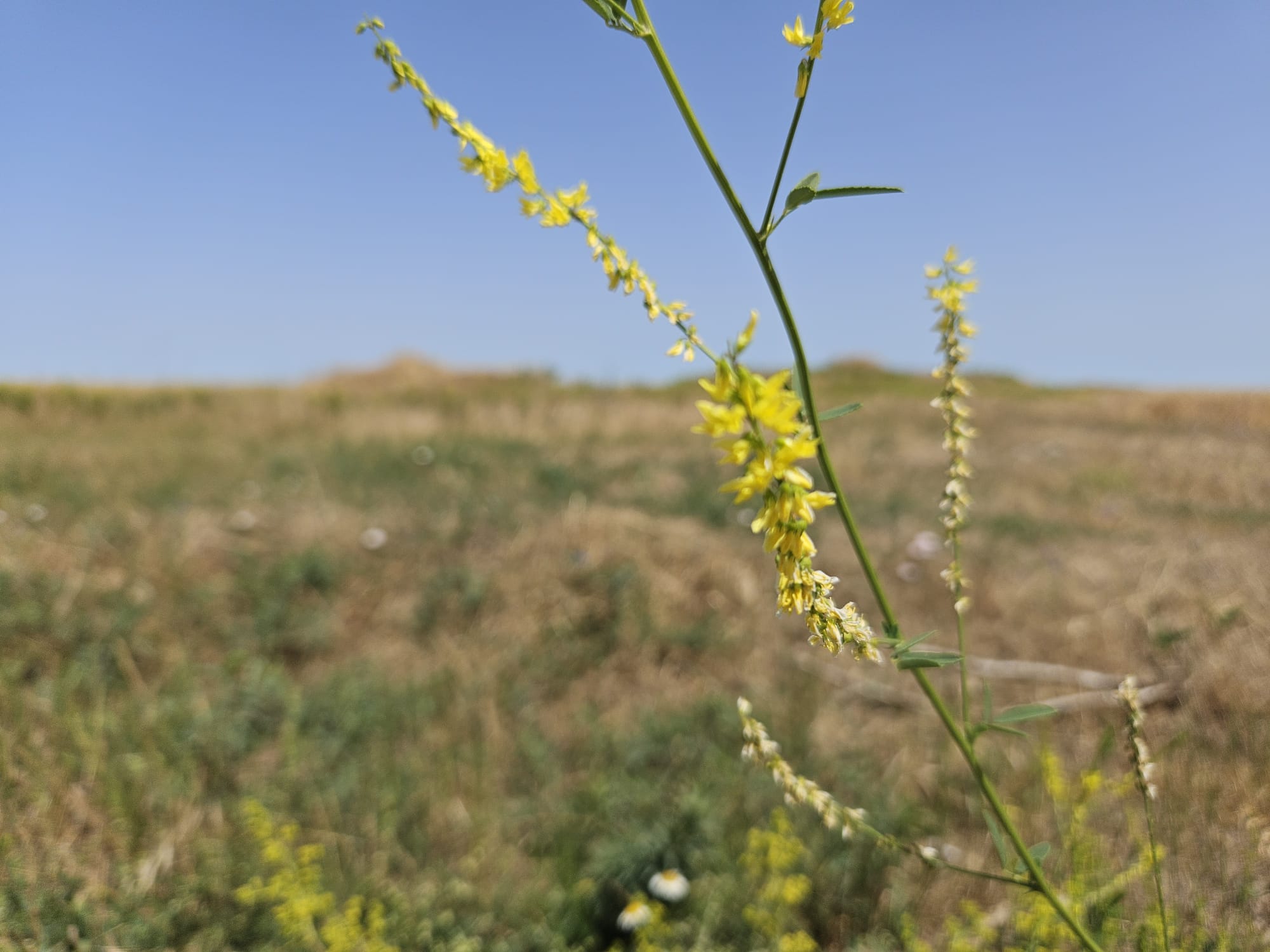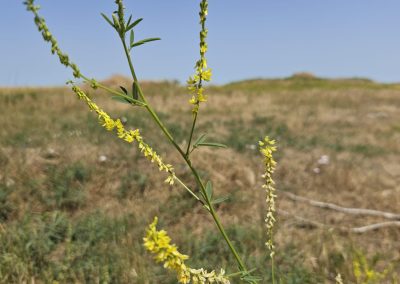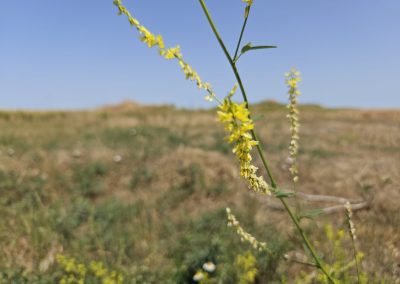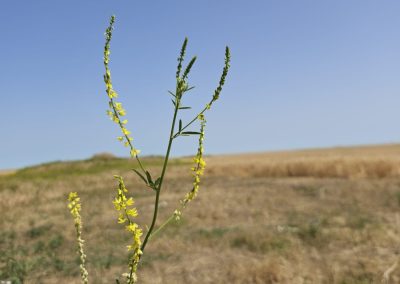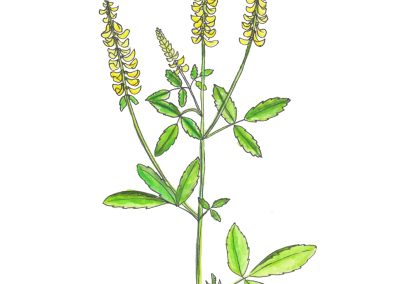Melilothus officinalis
Scientific description
Melilotus officinalis – sulphine
Phylum: Angiospermatophyta (Magnoliophyta)
Class: Dicotyledonatae (Magnoliatae)
Subclass: Rosidae
Order: Leguminosales (Fabales)
Family: Fabaceae
Origin: Northern hemisphere, continental and subtropical regions.
Description:
Herbaceous perennial. Taprooted, branched root with nitrogen-fixing nodules. Stem tall, cylindrical, glabrous, up to 2.5 m, much branched. Leaves trifoliate, petiolate, with lanceolate or obovate leaflets, short petiolate, toothed margins, narrow and long stipules. Flowers yellow, numerous (30–70), papilionate, fragrant, in racemes up to 10 cm long, opening from base to tip. Flower: five united sepals, five petals of different lengths (laterals longer than the upper), androecium of 10 stamens (9 united), gynoecium with pubescent ovary. Blooms June–September. Fruit: small indehiscent brown–blackish pod with one seed.
Propagation: by seeds at physiological maturity.
Ecology:
Grows in cultivated/uncultivated land, meadows, glades, and roadsides. Prefers sunny sites, low moisture demand, tolerates drought and frost.
Uses:
Medicinal: flowers and stem tip rich in coumarin, coumaric acid, tannins, mineral salts (vasodilator, liver-regenerating, sedative, expectorant, diuretic). Excellent honey plant. Coumarin extracted for perfumes and tobacco flavouring.
Melilotus officinalis – sulfină
Încrengătura: Angiospermatophyta (Magnoliophyta)
Clasa: Dicotyledonatae (Magnoliatae)
Subclasa: Rosidae
Ordinul: Leguminosales (Fabales)
Familia: Fabaceae
Origine: emisfera nordică, regiunile continentale și subtropicale.
Denumire populară: sulfină
Descriere:
Plantă perenă ierboasă. Rădăcina pivotantă, ramificată, cu nodozități fixatoare de azot. Tulpină înaltă, cilindrică, glabră, până la 2,5 m, foarte ramificată. Frunzele trifoliate, pețiolate, cu foliole lanceolate sau obovate, dințate pe margini, stipele înguste și lungi. Florile galbene, numeroase (30–70), papilionate și parfumate, grupate în raceme de până la 10 cm, deschizându-se de la bază spre vârf. Floarea cu 5 sepale unite, 5 petale inegale, androceu din 10 stamine (9 unite), gineceu cu ovar pubescent. Înflorește iunie–septembrie. Fruct: păstaie mică, indehiscentă, brun-negricioasă, cu o singură sămânță.
Înmulțire: prin sămânță, imediat după maturitatea fiziologică.
Ecologie:
Crește în locuri cultivate/necultivate, pajiști, poieni, pe marginea drumurilor. Preferă zone însorite, cu pretenții reduse față de sol și umiditate, rezistentă la secetă și ger.
Utilizare:
Plantă medicinală. Se folosesc florile și vârful tulpinii (conțin cumarină, acid cumaric, taninuri, săruri minerale). Acțiune: vasodilatatoare, regeneratoare hepatică, sedativă, expectorantă, diuretică. Excelentă plantă meliferă. Din sulfină se obține cumarina, folosită în parfumerie și aromatizarea tutunului.
Pericol: folosită pe scară largă în medicina tradițională.
Μελίλωτος (Melilotus officinalis) – Σουλφίνα
Φύλο: Αγγειόσπερμα (Magnoliophyta)
Κλάση: Δικοτυλήδονα (Magnoliatae)
Υποκλάση: Rosidae
Τάξη: Χεδρωπώδη (Fabales)
Οικογένεια: Fabaceae
Προέλευση: Βόρειο ημισφαίριο, ηπειρωτικές και υποτροπικές περιοχές.
Κοινή ονομασία: Σουλφίνα
Περιγραφή:
Πολυετές ποώδες φυτό. Ρίζα πασσαλώδης, διακλαδισμένη, με οζίδια δεσμευτικά αζώτου. Βλαστός ψηλός, κυλινδρικός, άτριχος, έως 2,5 μ., πολύκλαδος. Φύλλα τρίφυλλα, με μίσχο, φυλλάρια λογχοειδή ή ανεστραμμένα ωοειδή, πριονωτά στις άκρες, παραφύλλα στενά και μακριά. Άνθη κίτρινα, πολυάριθμα (30–70), πεταλοειδή, αρωματικά, σε βότρεις έως 10 εκ., ανοίγουν από τη βάση προς την κορυφή. Άνθος: 5 συγχωνευμένα σέπαλα, 5 άνισα πέταλα, ανδρείο με 10 στήμονες (9 συγχωνευμένοι), γύνοικο με εφηλό ωοθήκη. Ανθίζει Ιούνιο–Σεπτέμβριο. Καρπός: μικρή, άσχιστη, καστανο-μαυριδερή λοβόσχημη κάψα με 1 σπόρο.
Πολλαπλασιασμός: με σπόρους μετά τη φυσιολογική ωρίμανση.
Οικολογία:
Στην Ελλάδα αναπτύσσεται σε καλλιεργημένα και ακαλλιέργητα μέρη, ξέφωτα, λιβάδια, άκρες δρόμων. Προτιμά ηλιόλουστα, με χαμηλές απαιτήσεις σε υγρασία και έδαφος, ανθεκτική σε ξηρασία και παγετό.
Χρήσεις:
Φαρμακευτικό φυτό. Χρησιμοποιούνται άνθη και κορυφές βλαστών (κουμαρίνη, κουμαρικό οξύ, τανίνες, ανόργανα άλατα). Δράσεις: αγγειοδιασταλτική, ηπατοαναγεννητική, καταπραϋντική, αποχρεμπτική, διουρητική. Εξαιρετικό μελισσοκομικό φυτό. Από σουλφίνα παράγεται κουμαρίνη (άρωμα, καπνός).
Κίνδυνος: χρησιμοποιείται ευρέως στην παραδοσιακή ιατρική.
Melilotus officinalis – mélilot jaune
Embranchement : Angiospermatophyta (Magnoliophyta)
Classe : Dicotyledonatae (Magnoliatae)
Sous-classe : Rosidae
Ordre : Leguminosales (Fabales)
Famille : Fabaceae
Origine : hémisphère nord, régions continentales et subtropicales.
Description :
Plante herbacée vivace. Racine pivotante ramifiée avec nodules fixateurs d’azote. Tige haute, cylindrique, glabre, jusqu’à 2,5 m, très ramifiée. Feuilles trifoliées, pétiolées, folioles lancéolées ou obovales, dentées, stipules étroites et longues. Fleurs jaunes, nombreuses (30–70), papilionacées, parfumées, en grappes de 10 cm, s’ouvrant de la base vers le sommet. Fleur: 5 sépales soudés, 5 pétales inégaux, androcée de 10 étamines (9 soudées), gynécée à ovaire pubescent. Floraison juin–septembre. Fruit: petite gousse brune-noirâtre, indéhiscente, à une graine.
Multiplication : par graines à maturité physiologique.
Écologie :
Présente dans lieux cultivés ou non, prairies, clairières, bords de route. Préfère endroits ensoleillés, peu exigeante en sol et humidité, résistante sécheresse et gel.
Usages :
Médicinale: fleurs et extrémités de tiges (coumarine, acide coumarique, tanins, sels minéraux). Effets: vasodilatateur, régénérateur hépatique, sédatif, expectorant, diurétique. Excellente plante mellifère. Coumarine utilisée en parfumerie et aromatisation du tabac.
Creative writing inspired by Melilothus officinalis
Written by Mara Parfinov
The Poison and the Cure
Once upon a time, there was a distant kingdom. And over that kingdom ruled a king known by all. That king had a daughter. But what a daughter she was! Beautiful, kind, intelligent... she had all the virtues. But most importantly, she was always good at heart. She always forgave and helped others.
One day, as she was walking through the streets of the kingdom, an old woman appeared before her. The girl looked at her, puzzled. “What could this old woman want from me?” She wondered. The old woman politely asked if she could pick a mysterious flower called the Yellow Sweet Clover from the field, as her back ached from old age. The girl had never heard of this flower before, but she agreed, feeling sorry for the poor woman. They went to the field, and the old woman pointed out the flower. The girl, suspecting nothing, plucked it, but suddenly, her hand began to go numb, and a terrible rash appeared. She looked at the old woman in shock. What was happening? The woman gave her a sly look, and a cunning smile appeared on her face. She ripped out only the root of the flower, leaving the stem in the girl’s hand. Then, she revealed that the stem was poisonous and that once touched, it would cause severe redness and illness. The girl stared at her, confused, and asked why she had done such a thing. The old woman answered that she wanted to take control of the kingdom and rule it for the rest of her life. The princess realized she had been tricked and that the woman was a witch. The old woman clapped her hands three times and vanished into thin air.
The girl started crying and returned to the palace. When the king saw her hands, he immediately sent several maids to wash and care for her. However, days passed, and the girl grew weaker and weaker. The king did not know what to do. The girl told him everything that had happened. Upon hearing this, the king remembered his own mother, who had suffered from the same illness caused by the very same flower. He also recalled that his mother had died before he could discover the cure. But now he knew what it was, and he would not let his daughter perish. There was only one ingredient needed for the cure. And it was… the very flower that had poisoned her... Yellow Sweet Clover. But only its blossom could heal her. The king went to the field and searched for hours but could not find another flower like it. He was in utter despair. But suddenly, he saw a mysterious figure with a hood over their head, holding in their hand… a fresh Yellow Sweet Clover bud. It was the witch. The king ordered her to hand over the flower, or he would kill her. But the woman was clever and began throwing colorful lightning bolts at him, trying to end his life. The king suddenly recalled a book he had read years ago, about witches and how they could be defeated. The heart. The heart was their weakness. If struck, they would lose their power and die. However, it was not a physical blow that was needed, but words... something so painful that it would shatter their heart into pieces. The king thought carefully and… bingo! He found the perfect words. “You will never be as powerful as your father.” The words struck deep. The old woman fell to the ground. The king watched as the old woman’s heart shattered into pieces.
It had all happened very quickly, but he remembered why he had done all this. For the flower. He took it from the fallen woman’s hand and rushed back to the palace. The girl was still lying in bed, too weak to move. Her father prepared the medicine using the flower. She drank it, and within a few days, she regained her strength. It was as if she had been brought back to life. A bright smile returned to her face, and she felt better than ever. Yet, she still wanted to know what had healed her. So, she asked her father. When she heard the answer, she could hardly believe it... the very flower that had once nearly destroyed her. From that moment on, the girl looked at the flower differently... not with fear, but with gratitude. She realized that life was full of surprises and that sometimes, healing comes from the most unexpected places.


